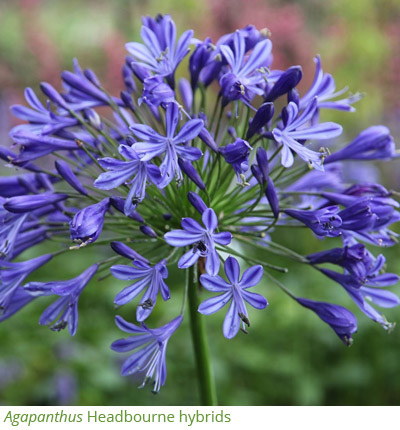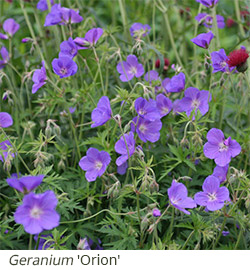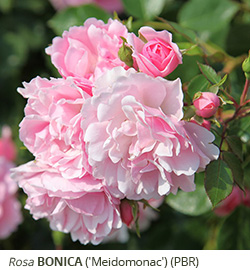We are into high summer now and gardens should be at their best, although the days are already getting shorter again. As the days shorten, southern hemisphere plants begin to shine and the South African agapanthus is one of the most useful in July because its pigment-packed petals come in many shades of blue. This is a rare colour in summer and it’s especially eye catching in evening light, when blue takes on an extra resonance and iridescence.
 These rugged plants, which have rubbery stems and flowers that shrug off wind, sun and rain, are found growing naturally on The Cape. There are 6 – 10 species, depending on which botanist you believe, and they grow on both sides of The Cape so they are exposed to very different conditions. Those on the western side get most of their rainfall in winter, so agapanthus species from this area have lush, wide foliage and an evergreen tendency. These rugged plants, which have rubbery stems and flowers that shrug off wind, sun and rain, are found growing naturally on The Cape. There are 6 – 10 species, depending on which botanist you believe, and they grow on both sides of The Cape so they are exposed to very different conditions. Those on the western side get most of their rainfall in winter, so agapanthus species from this area have lush, wide foliage and an evergreen tendency.
Those on the eastern side of The Cape have a colder climate in winter and their rainy season occurs in summer. These agapanthus are deciduous and therefore hardier. Most named agapanthus have a deciduous tendency and they are hardier than gardeners think. Many are hybrids with extra vigour. They all make great cut flowers and the choice is wider than it’s ever been.
Agapanthus get a season of rain in the wild, regardless of which side of The Cape they (or their ancestors) came from. So it's a total myth that you should starve agapanthus in your garden. They need plenty of water to perform well and they also flower far better when they're given a potash-rich feed every two weeks from April to August inclusive. Tomato food, which is easy to water on, is ideal. Choose a frost-hardy pot with straight sides to prevent your plants from getting blown over. Pot feet are a good idea as well, because they like good drainage at the root.
When winter beckons, move your agapanthus into an unheated greenhouse or lay the pots on their sides in a sheltered part of the garden. This will keep winter wet out. Their roots are fleshy and can get harmed by cold conditions so agapanthus are best moved to a frost-free position for winter, or they can be mulched if they’re in the garden. Begin to reduce watering during September, to dry out the compost and slow growth. Then your plants can be started off again in March or April by watering them modestly at first.
 You can grow agapanthus in a sheltered position in the garden, but most gardeners prefer to containerise theirs. This has two main advantages. Firstly they’re movable feasts and they can add a blast of colour to parts of the garden that are looking a little drab. Having them in pots also gives them extra height and makes them look far more impressive. They gain roughly two feet in height and their stems splay out like flowers in a vase. You can grow agapanthus in a sheltered position in the garden, but most gardeners prefer to containerise theirs. This has two main advantages. Firstly they’re movable feasts and they can add a blast of colour to parts of the garden that are looking a little drab. Having them in pots also gives them extra height and makes them look far more impressive. They gain roughly two feet in height and their stems splay out like flowers in a vase.
Fifty years ago there were few agapanthus on offer and gardeners generally thought them too tender to grow outside, possibly due to their exotic-looking flowers. The Headbourne hybrids, developed by Lewis Palmer of Headbourne Worthy near Winchester in the 1950’s, proved that they were hardier than people imagined. Headbourne hybrids are still available, but several plant breeders have raised and named new varieties. The advent of micro-propagation, growing pieces of tissue in rotating glass jars under lights, has meant that new ones could be bulked up into thousands within a couple of years. So we have great choice and the micro-propped plants are dense and bushy because the glass flasks rotate.
My own personal favourite is still ‘Northern Star’, a deciduous variety that looks good at every stage. The neat, bright-green foliage is shaded in purplish black at the base and then lots of neat, deep-blue flowers, with purple-striped tepals, perch on top of rubbery dark stems. ‘Northern Star’ was raised close to Dartmoor in Devon by Dick Fulcher and he considers ‘Northern Star’ to be one of his best. He also raised ‘Taw Valley’, another deep-blue and these strong blues can be flattered by bleached grasses such as the taller Stipa gigantea and ponytail grass Stipa tenuissima. Or they can stand alone.
 The similarly named ‘Midnight Star’ is also highly rated by agapanthus lovers and this dark-blue, deciduous agapanthus was named over forty years ago by plantswoman Lady Priscilla Bacon of Raveningham Hall in Norfolk. It’s terrifically hardy and floriferous and Lady Bacon made several trips to South Africa to collect plants and seeds, in an era when this was allowed. This one was a Beth Chatto favourite, because it forms great seed heads, but Lady Bacon grew it as a cut flower. The similarly named ‘Midnight Star’ is also highly rated by agapanthus lovers and this dark-blue, deciduous agapanthus was named over forty years ago by plantswoman Lady Priscilla Bacon of Raveningham Hall in Norfolk. It’s terrifically hardy and floriferous and Lady Bacon made several trips to South Africa to collect plants and seeds, in an era when this was allowed. This one was a Beth Chatto favourite, because it forms great seed heads, but Lady Bacon grew it as a cut flower.
There are also soft-lilacs and, although these don’t make as much impact, they do look very summery and feminine. ‘Liam’s Lilac’, named after Dick Fulcher’s grandson, and ‘Meghan’s Mauve’, another from Dick Fulcher, are both excellent. ‘Meghan’s Mauve’, which is very topical at the moment, has lilac petals striped in purple so it avoids looking wishy washy. ‘Liam’s Lilac’ has pale-lilac flowers that emerge from dark buds. If you want something taller, opt for the almost-grey ‘Windsor Grey’. This evergreen agapanthus produces large heads of pale flowers and it’s been universally popular since it was raised on the Crown Estate at Windsor in 1995.
‘Castle of Mey’, raised on the Crown Estate in 1975, has dark, violet-blue flowers. It produces lots of smaller heads of flower so this would be an excellent one for a container, or for cut-flower patch. It has stood the test of time and is still highly thought of. The later-flowering ‘Purple Delight’ is an evergreen agapanthus with bright-green stems and lush foliage.
 There are always new agapanthus coming up and Agapanthus africanus TWISTER has flowers with purple-blue bases and white outer petals. Or you could go for a pure-white such as ‘Snow Cloud’. This impressive, strong-stemmed white agapanthus can rise to 4 feet (120cm) and the strong green stems are topped with almost-circular white flowers. White always looks better in a bright position, rather than in full sun. There are always new agapanthus coming up and Agapanthus africanus TWISTER has flowers with purple-blue bases and white outer petals. Or you could go for a pure-white such as ‘Snow Cloud’. This impressive, strong-stemmed white agapanthus can rise to 4 feet (120cm) and the strong green stems are topped with almost-circular white flowers. White always looks better in a bright position, rather than in full sun.
Don't allow your agapanthus to become pot bound because they can be impossible to remove from the pot. Tackle the job in March or April, as the plants come into growth. Cut or saw the clump apart and this does take muscle. Re-pot large pieces into slightly larger pots and grow on. If the division has too much space around it, it puts on leaf at the expense of flower.
Growing agapanthus is not onerous and these long-lived dazzlers really lift the garden in high summer.
|













